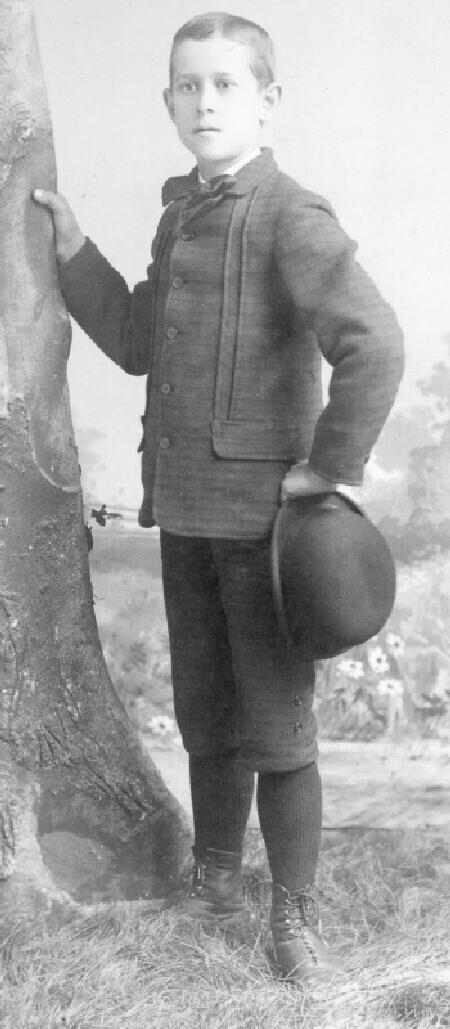
Boys' Suit Jackets: Buttons

Figure 1.--This late 19th century boys' suit jacket had five buttons in stead of the bow common three buttons. Part of the reason was the small, high placed lapels. Note the slight Norfolk styling. This unidentified portrait is undated, but we know the boy was from Reading, Pennsylvania. Eventually three buttons became more standard in sack suits. Note the bowler hat.
|
The issue of buttons somewhat complicates a consideration of style. Certain jacket styles like the skeleton suit jacket or the very permutations of Eton jackets have been worn with different numbers of buttons. Blazers have been made in both single and double-buttoned styles. Buttons have been used in a wide variety of ways on boys' suit jackets. The first boys' jackets, worn with the skeleton suit, could have large numbers of buttons. Fauntleroy jackets were often worn open or one button. Initially most styles like Eton, Suffolk jackets as well as blazers and sports jackets were worn with a varying number of buttons. Eventually three buttons became standard on many of these suits. Norfolk jackets tended to have more buttons. This standardization developed in the late 19th century as mass-produced eady-made clothing gradually dominated the market. Saville Rowe eventually ordained the two button single breasted jacket. Single breasted jackets have generally had two or three buttons, some were even made with one--simplifying the question of which to button. Two buttons are today the standard--ordained by Savile Row. Only the upper button of a two button blazer should be buttoned. The reason is that a jacket is balanced to close at that point--thus it just looks better. The lower bytton should not be fastened, certainly not by itself, but even along with the top button. Another popular style was the double breasted jacket worn with two rows of buttons.
Blazers
We believe that most blazers had three buttons, but can not yet confirm this.
I am not sure when double breasted style first appeared or who designed them. They almost certainly were inspired by the military uniforms of the early 19th Century. Flashy turn of the 19th century military uniforms for officers often had row after row of buttons amd elaborate trin. Double breasted styles were used in military uniforms well into the 20th Century. I do not yet have any historical information. I am collecting available images
which hopefully will provide some insights on the development of this important style.
Eton Suits
Here we have two kinds of suits. There are the Eton suits worn at Eton and other English schools as well as for non-school dress wear. The other kind of Eton suit is the one worn by younger Amerivan boys in the 20th century. We are not yet sure about the buttoning of these jackets.
Fauntleroy Suits
There were different kinds of Fauntleroy jackets. Some were small cut-away jackets worn open or closed at the top with only one button to display a fancy blouse. Others were worn buttoned at the collar and enclosing the blouse. Buttoning was thus highly variable.
Military-style Jackets
We notice collar buttoning with military styling that were popular in the mid-19th century. They were done with a prominant role of shiny buttons, presumably brass buttons. They look to have been done in black or navy vlue. They were often worn with small white collars. A good example is Elisha Dickerman, an American boy about 1850.
Norfolk Suits
Norfolk jackets tended to have more buttons than single-breasted sack suits.
Rugby Suits
We do not yet have a great deal of information about Rugby suits. They appear to be single-breasted jackets worn with short pants. We are not yet sure about the buttoning.
Single-Breasted Suits
Most modern single-breasted suits comes with either two or three buttons. We are not yet sure about historic suits, but believe that three buttons gradually became standard. Saville Rowe eventually ordained the two button single breasted jacket. Single breasted jackets have generally had two or three buttons, some were even made with one--simplifying the question of which to button. Two buttons are today the standard--ordained by Savile Row. Only the upper button of a two button blazer should be buttoned. The reason is that a jacket is balanced to close at that point--thus it just looks better. The lower bytton should not be fastened, certainly not by itself, but even along with the top button.
Skeleton Suits
We believe that buttoning of skeleton suits were highly variable. Skeletin suits were not mass produced and as a result there are suits with a highly variable number of buttons.
HBC

Navigate the Historic Boys' Clothing Web Site:
[Return to the Main suit jacket page]
[Introduction]
[Bibliographies]
[Bibliographies]
[Biographies]
[Chronologies]
[Contributions]
[Essays]
[FAQs]
[Frequently Asked Questions]
[Style Index]
[Boys' Clothing Home]
Navigate the Historic Boys' Clothing Web chronological pages:
[Early 19th century]
[Mid-19th century]
[The 1860s]
[The 1870s]
[The 1880s]
[The 1890s]
[The 1900s]
[The 1910s]
[The 1920s]
[The 1930s]
[The 1940s]
[The 1950s]
[The 1960s]
[The 1970s]
[The 1980s]
Navigate the Historic Boys' Clothing Web style pages:
[Skeleton suits]
[Eton suits]
[Norfolk jackets]
[Kilts]
[Knicker suits]
[Blazers]
[Short pants suits]
[Long pants suits]
Created: December 21, 1999
Last updated: 6:37 PM 1/16/2007


